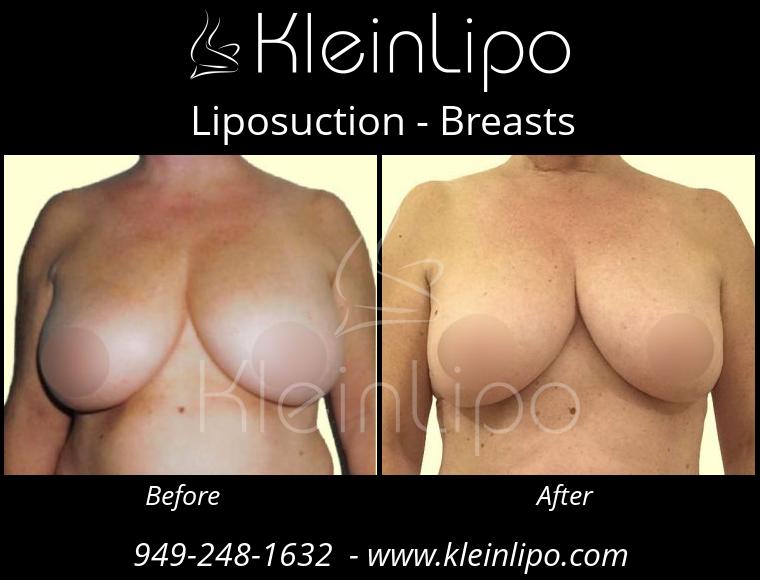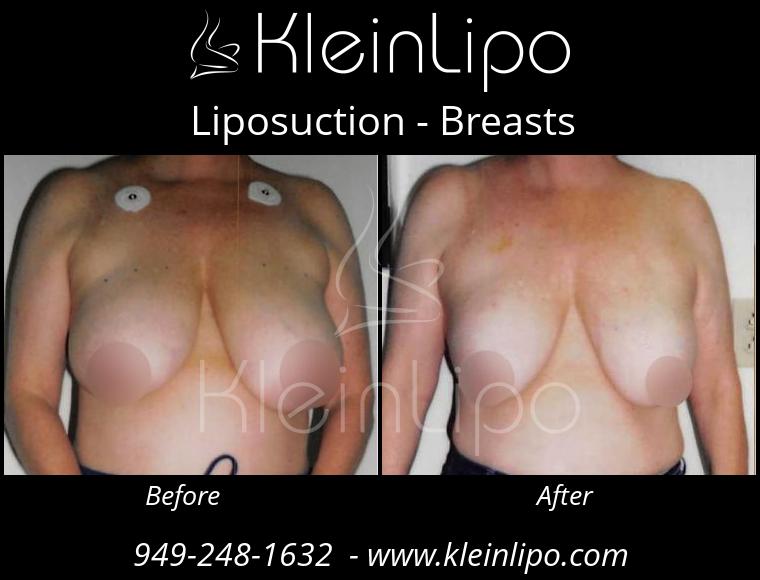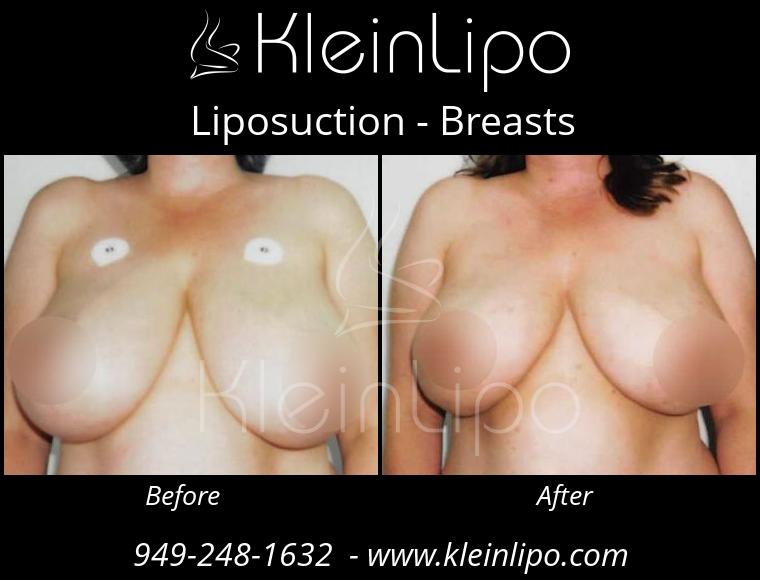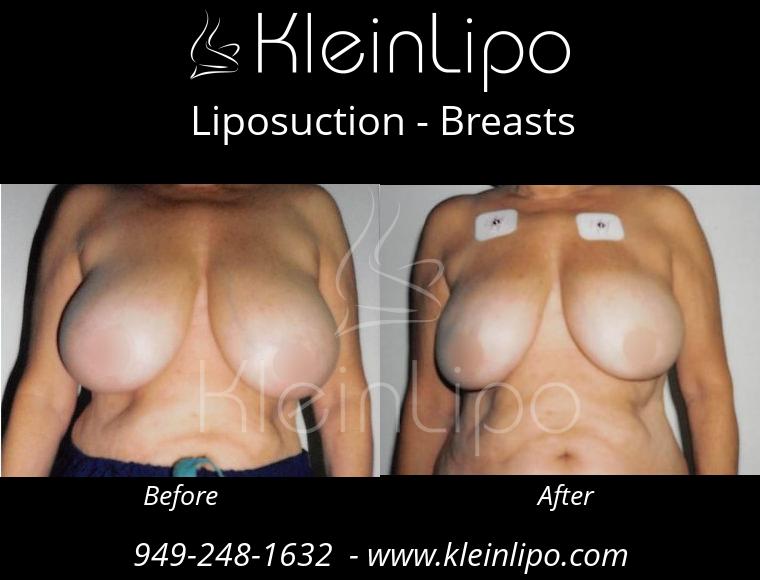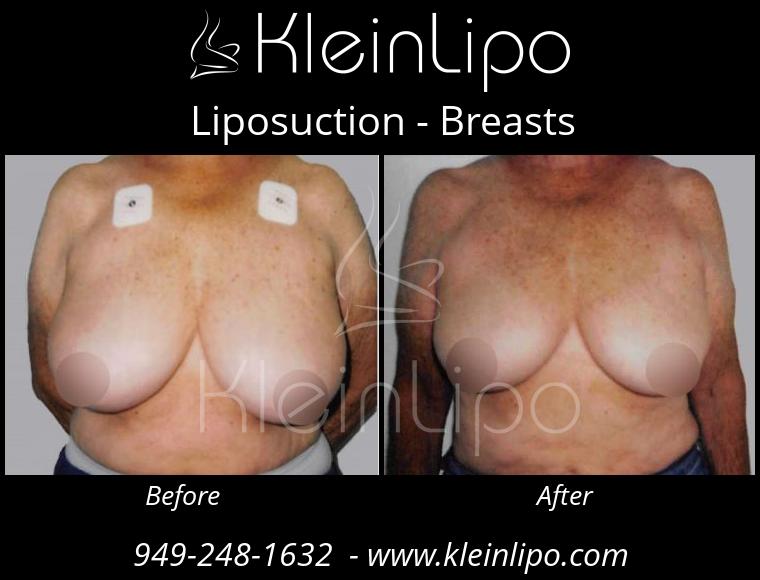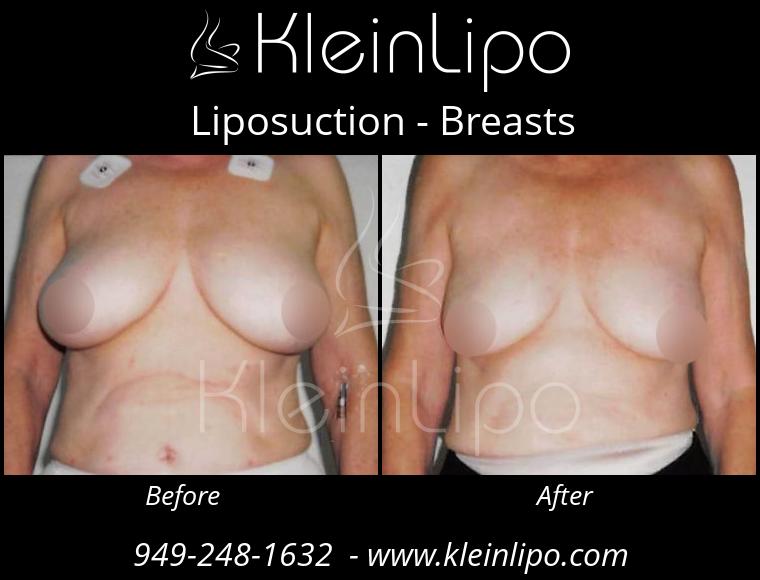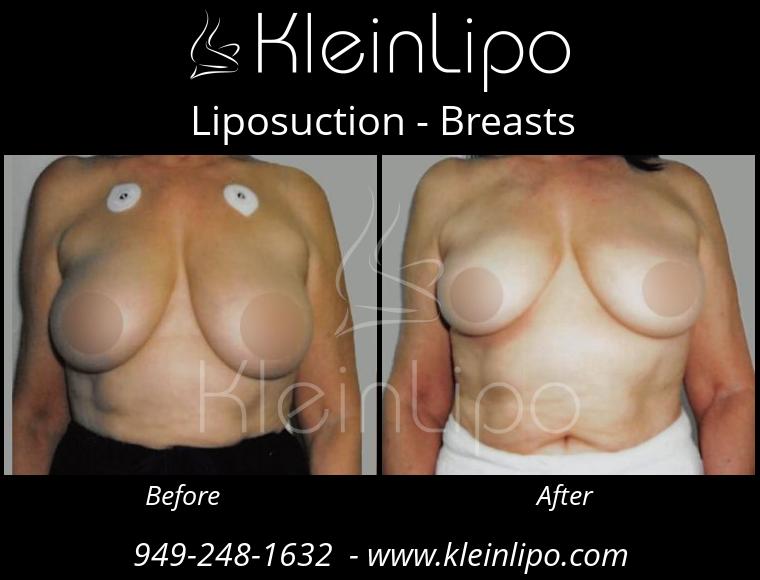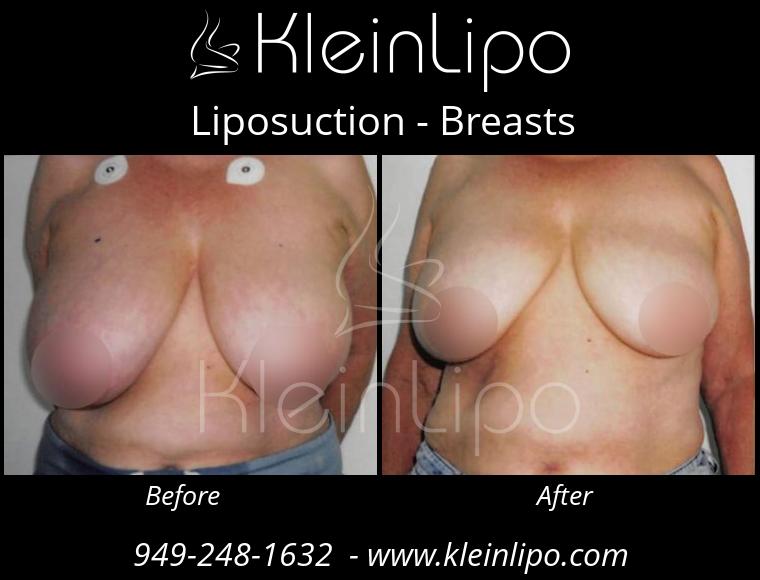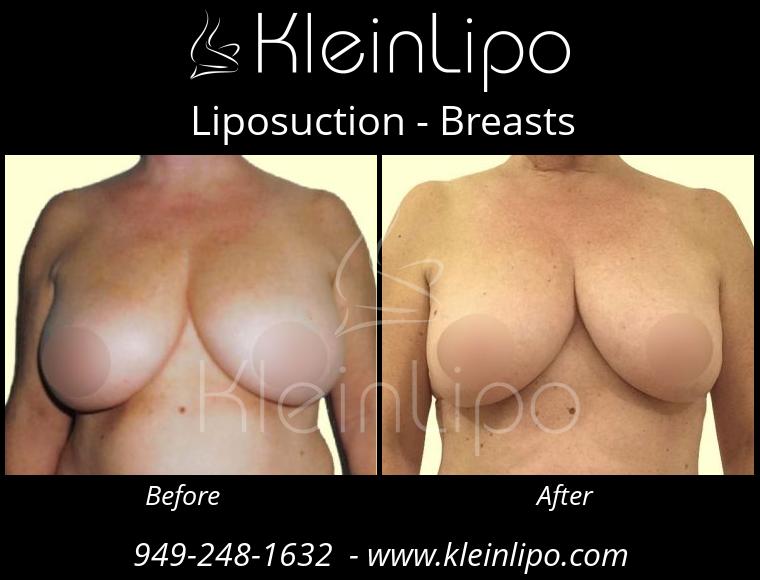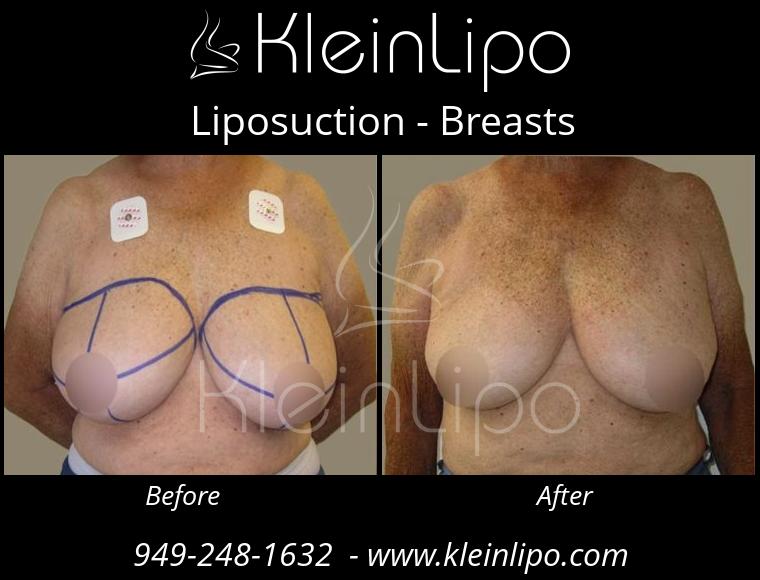Breast Reduction Surgery by KleinLipo
Tumescent Liposuction of the Female Breast
Breast reduction surgery is performed using tumescent liposuction totally by local anesthesia can produce both a significant breast reduction and a moderate but gratifying breast lift. The use of microcannulas permits female breast reduction surgery with minimal postoperative pain, rapid postoperative recovery, quick return to normal activities, and virtually no scaring. Not only can liposuction reduce the female breast by more than 50 percent in size, the breasts are also lifted to a significant degree. This breast lift is the result of the reduced weight of the breast, which allows the breasts’ natural elastic properties to contract and produce elevation. The breasts do not change shape after breast reduction surgery perfomed using tumescent liposuction, they simply become smaller and somewhat elevated. After breast reduction surgery, the breast’s shape is simply a smaller version of the shape before liposuction surgery.
View additional before & after photos and read patient testimonials.
No Surgical Scars!
Surgical scars are not visible in most patients after breast reduction surgery by tumescent liposuction using microcannulas. Evidence of micro-incisions usually disappears within a few months. The use of microcannulas permits the use of extremely small round incisions that are 1 millimeter (approximately 1/25 of an inch) in diameter. These tiny incisions produce scars that are much smaller than 1 millimeter and therefore almost invisible. In contrast, traditional breast reduction surgery is associated with much larger scars and more visible scars. Patients whose natural skin color is darkly pigmented can expect to have some tiny spots of increased pigmentation at the incision sites where the microcannula enters the skin. This post-inflammatory hyperpigmentation usually fades away after 1 to 2 years.
Breast Reduction by Tumescent Liposuction Lifts the Breasts
Both breast reduction and breast lift can be accomplished by tumescent liposuction. Liposuction reduces breast size in direct proportion to the volume of fat removed. Liposuction reduces the weight of the breast and allows the natural elastic tissue in the breast to retract and produce a visible breast lift.
Older Techniques for Breast Reduction Surgery
Older techniques for breast reduction, known as surgical-excision breast reduction, involved cutting the breast with a scalpel to excise or remove large amounts of breast tissue. Problems associated with surgical-excision breast reduction include the risk of keloids or excessively large scars, uneven sized breasts, abnormal appearance of the skin near the nipple, impaired nipple sensation, and possible nipple damage. Other risks include bleeding, blood clots or hematoma in the breast, seromas (fluid collection in the breast), fat necrosis with cyst formation in the breast, and scarring of the deep breast tissue that can produce mammogram abnormalities. Besides requiring general anesthesia, breast reduction surgery by excision is also associated with significant pain and prolonged recovery.
Advantages of Breast Reduction Surgery by Liposuction
Advantages of breast reduction by tumescent liposuction using microcannulas include:
- Rapid recovery. The typical patient can return to work and normal social activity within two to three days after breast reduction surgery.
- Virtually no scars
- Reduction of 20 to 50 percent of the breast volume
- Minimal risks of postoperative complications.
Problems with Excessively Large Breasts
Excessively large female breasts cause pain and suffering, physical impairment and psychological problems. Athletic activity is significantly limited. Chronic changes in posture in an effort to compensate for the weight of excessively large breasts can lead to chronic pain in the back, neck, and shoulders. Chronic pressure from bra straps can cause permanent indentations of the shoulders. Large breasts can predispose women to candida yeast infections of the skin in areas where the skin rubs together, such as between the breasts and beneath the breasts. A woman who has very large breasts may regard them as cosmetically undesirable. Finding a bra that fits and is comfortable may be impossible. Clothing does not fit well.
Who is a Good Candidate?
Some women are likely to have better results than other women after breast reduction by liposuction. Tumescent breast reduction totally by local anesthesia is only appropriate for a certain subset of women. However, for the appropriate patient, the results of tumescent liposuction can be extremely gratifying. The best candidates for breast reduction by tumescent liposuction have breasts that contain a large proportion of fat. For example, women who have passed through menopause typically have breasts that contain a larger proportion of fat than do teenagers. A good candidate must also have realistic expectations.
Breasts Containing a Large Proportion of Fat
After menopause, much of the glandular tissue in the breasts is replaced by fatty tissue, thus, old women with large breasts are usually very good candidates for tumescent liposuction of the breasts. Young women who continue to have menstrual periods and are somewhat overweight might also have breasts that contain a significant amount of fat, and therefore would also be good candidates for liposuction of the breasts. The proportion of fat in the female breast can be determined by a mammogram.
Realistic Expectations
Breast reduction surgery by liposuction will produce a smaller version of the breasts that a woman had before liposuction. One can expect the breasts to be significantly smaller, to be elevated and to show virtually no scars after breast reduction surgery. However, the breasts’ overall shape will be very similar to their shape before liposuction. Liposuction will usually not produce young “perky” breasts. The elevation of breast position is the result of decreased breasts’ weight and the elastic properties of the suspensory ligaments in the breast.
Who is Not a Good Candidate? For Breast Reduction Surgery
Not every woman is a good candidate for breast reduction surgery by tumescent liposuction. Some women have breasts that will require traditional breast reduction surgery with large excisions and large scars. Women who are not ideal candidates for breast reduction surgery by liposuction include those whose breasts contain more glandular tissue than fat tissue.
Unrealistic Expectations
Women who expect perfect breasts after liposuction breast reduction surgery have unrealistic expectations. For example, most women who have had a baby, should not expect breast reduction surgery to recreate the “perfect” breasts of a virgin. There is usually no surgical procedure that can achieve this unrealistic goal.
Excessively Pendulous Breasts
Excessively pendulous breasts usually contain only a small proportion of fat. If breasts that appear to sag or droop significantly and contain only a small amount of tissue, then breast reduction surgery by liposuction will not provide satisfactory cosmetic improvement. Such “empty” breasts contain little fat and therefore will not be improved by liposuction. Cosmetic improvement of “empty” breasts usually requires excision of skin, as well as breast implants.
Thin Young Women
Thin young women who have breasts containing mostly glandular breast tissue with little fat are often not good candidates for breast reduction surgery by liposuction. For example, a relatively thin woman with large breasts often has breasts that contain a high proportion of glandular breast tissue and almost no fat. In such cases there is little fat in the breasts and liposuction will not produce a significant breast reduction.
Excessively Large Breasts
Breast reduction surgery by liposuction can usually be expected to provide no more than a 55 percent reduction in breast size. Women who need more than a 55 percent reduction in breast size might be happier with the results of traditional surgical breast reduction surgery despite the unsightly scars associated with the excision of skin and breast tissue.
Excessively Dense Breast Tissue
Some women have breasts that contain a large proportion of glandular tissue, and relatively little fatty tissue. Breast reduction surgery by liposuction can remove fat, but glandular breast tissue is largely resistant to liposuction. Fibrocystic disease of the breast can make liposuction more difficult. However, when fibrocystic disease is only mild to moderate in degree then some women can achieve sufficient results.
Existence of a Breast Lump
Any significant breast mass must be evaluated with a mammogram and possibly a breast biopsy prior to breast reduction surgery. Cosmetic breast reduction surgery is not appropriate until the surgeon has established that there is a minimal likelihood of breast cancer. Breast surgery in any patient with a significant family history of breast cancer requires very careful consideration and detailed informed consent.
Milk Production After Breast Reduction
If a woman becomes pregnant after tumescent liposuction of the breasts, there is a reasonable chance that she will be able to breast feed. With the use of microcannulas, breast reduction tumescent liposuction produces very little damage to the glands and ducts that produce milk. In contrast with other breast reduction surgery techniques that use scalpels to cutout large portions of breast tissue, the glands and ducts are usually damaged and blocked by excessive scar tissue that prevents milk production and breast feeding.
Preoperative Mammograms
Preoperative mammograms should be considered in order to rule out existing malignancies, and to establish a up-to-date baseline mammogram with which future mammograms might be compared. Similarly, after breast reduction surgery, mammograms should be done within 3 to 6 months in order to establish new base-line mammograms. With traditional breast reduction by surgical excision, it is not uncommon to encounter postoperative inflammatory nodules, and lipid filled pseudocysts. These conditions may make it difficult to interpret future mammograms without good baseline mammograms for comparison. Inflammatory nodules and pseudocysts are rare after tumescent liposuction of the female breast.
Minimal Trauma to Breast Tissue
Breast reduction by liposuction removes fatty tissue from the breast, and mostly spares the glandular breast tissue that is responsible for the production of milk. There is so little trauma to the breast tissue that x-ray examinations of the breast, known as mammograms, usually appear normal after breast reductions done using microcannula liposuction of the female breast. In contrast, after excisional breast reduction surgery, x-ray mammograms show calcification and other changes in appearance.
Breast Reduction Surgery After Menopause
After menopause, breast reduction surgery by liposuction becomes relatively easy. Before menopause, a woman’s breasts contain a higher proportion of fibrous glandular breast tissue. Glandular breast tissue is not easily removed by liposuction. However, after menopause, breasts contain a significantly higher amount of fat that is easily removed by liposuction. Breast reduction surgery by liposuction is easier in women who have already gone through menopause. Younger women often benefit significantly from breast reduction liposuction, but liposuction of younger women’s breasts usually requires significantly greater effort, compared to older women.
How Can There Be Almost No Scars?
For breast reduction using micro cannulas, the holes that are made in the skin are extremely small, only 1 millimeter (mm), smaller than a toothpick. These small holes are called adits, and they serve several useful functions (see The Functions of Adits). Adits are made with a skin biopsy punch. An adit is so small that it heals with virtually no visible scar. Because the skin of the breast is stretchy and elastic, the opening of a 1 mm adit can easily be stretched to accommodate liposuction cannulas with outside diameters ranging from 1.5mm to 2.8 mm. Typically 8 to 12 adits are placed in a random pattern on each breast. By using adits there is no need for larger incisions and thus there are no larger scars after breast reduction surgery.
The Functions of Adits
Adits are openings in the skin that permit 1) insertion of the needle that injects the solution of tumescent local anesthesia, 2) insertion of microcannulas (very small liposuction cannulas) that suck-out the fat, and 3) openings that maximize the post-operative drainage of residual blood-tinged local anesthetic solution which minimizes swelling and bruising.
Local Anesthesia Vs General Anesthesia
Breast reduction by tumescent liposuction using microcannulas can be accomplished totally by local anesthesia or with general anesthesia. Liposuction can be accomplished safely with either local anesthesia or general anesthesia. Local anesthesia is usually considered safer than general anesthesia (this is why dentists prefer to use local anesthesia). In the hands of a surgeon who is well trained and experienced at doing liposuction totally by local anesthesia, breast liposuction is routinely accomplished with virtually no pain. Surgeons who have not had specific training in liposuction totally by local anesthesia are usually unable to accomplish tumescent liposuction without the use of heavy IV sedation or general anesthesia.
Measurement of Breast Volume
The volume of each breast is measured by a water-displacement method. Measuring the breast volume is accomplished by immersing the breast in a beaker full to the brim of comfortably warm water; after removing the breast from the beaker, the volume of water necessary to refill the beaker to its brim is recorded. The average of two repeated measurements provides a reasonably accurate estimate of each breast’s volume. An accurate measurement of breast volume is necessary for planning the amount of fat to be removed from each breast. If the breasts are originally unequal in size, then the surgeon can remove an appropriate extra volume of fat from the larger breast, and thus improve the symmetry of the breasts.
Step-by-Step Liposuction Breast Reduction Surgery Totally by Local Anesthesia:
- Measure the volume of each breast.
- Use indelible ink to draw lines on the breasts that will help the surgeon during the infiltration process, and during surgery.
- Use the smallest possible needle to painlessly inject a small volume of local anesthetic into the skin in the exact locations where adits will be placed.
- Create 1 mm diameter adits in the skin using a skin biopsy punch.
- Complete the infiltration of the tumescent local anesthesia. The total volume of local anesthesia infiltrated into a breast will be approximately equal to the original preoperative volume of the breast.
- Do liposuction of the breast using microcannulas that range in diameter from 1.5 mm to 2.7 mm.
- After liposuction is completed, super-absorbent HK Pads are placed on the breast to absorb the blood-tinged tumescent fluid that drains from the adits after surgery.
- Put on a spandex HK Breast Compression Garment to hold the pads in place.
- Place additional adjustable elastic HK binders on top of the spandex garment to increase the degree of compression and thus encourage more complete drainage of the blood-tinged tumescent fluid.
- Shower and change HK Pads twice daily for the next few days. Most patients can discontinue the use of HK Breast Compression Garments within 3 to 6 days.
Breast-Feeding After Breast Reduction
Breast-feeding after breast reduction is a more likely possibility after liposuction using microcannulas than after a surgical excision. Because there is minimal trauma to glandular breast tissue, and because of the normal appearance of post-liposuction mammograms (X-rays of the breast), it is reasonable to predict that a breast reduction by tumescent liposuction should not interfere with future lactation. Breast-feeding may not be possible after traditional surgical-excision breast reduction because the excisions and subsequent scaring severs and blocks the milk ducts.
Mammograms Before & After Breast Surgery
(X-ray of the breast) detect breast cancer by revealing tiny white specks (calcifications) within the breast tissue. Any surgery of the breast can result in postoperative calcifications that might hinder the detection of breast cancer by a mammogram. It is important to compare mammograms done before and 6 months after breast reduction in order to detect any new calcifications caused by breast surgery. Calcifications caused by surgery typically look different from calcifications due to cancer. Nevertheless, any new breast calcifications that are not documented soon after surgery might later be confused with evidence of breast cancer. Calcifications are uncommon after breast reduction by tumescent liposuction. In contrast, calcifications after breast reduction by traditional surgical-excision are frequent.
Normal Healing Process
After tumescent liposuction of the female breast, there is a gradual decrease in postoperative swelling over the subsequent 8 to 16 weeks. With the use of open-drainage and proper compression garments, there is very little, if any, bruising. Breast lumps immediately after liposuction: Liposuction of the female breast is occasionally associated with temporary lumpiness that can persist for several weeks after surgery. This temporary lumpiness, which can be felt with the fingers but is not visible, is part of the normal healing processes.
Post-Operative Breast Compression
Optimal breast compression after any form of breast reduction surgery will minimize the occurrence of temporary post-operative lumpiness, accelerate the healing process, and decrease post-operative pain, swelling and bruising,. Without open-drainage (tiny incisions are not closed with sutures) and adequate external breast compression in the immediate post-liposuction period, there is an increased risk of bleeding, bruising, or hematomas.
Breast Compression Garments
Special Adjustable Breast Compression Garments have been designed to allow easily adjustable compression. If the compression is too slight, there is a risk of subcutaneous bleeding. If the compression is too tight, the patient may experience pain or difficulty breathing. The solution to this situation is to use an adjustable compression garment so that the patient can easily adjust the compression to the maximum comfortable level at any time.
The Three Stages of Breast Compression
Day 1: The first 12 to 18 hours after breast liposuction requires the maximum compression that the patient can tolerate comfortably; this relatively intense compression is necessary to minimize the risk of postoperative hematomas and limit the amount of bruising.
Day 2: The day after surgery, while there is some drainage, the compression is adjusted to a moderate level that is maintained for at least 48 hours and for 24 hours beyond the time when all drainage has ceased. Compression for comfort. After all drainage has ceased, the degree of compression is reduced again to a level that is sufficient to give comfort and support.
The HK Breast Garment
The HK Breast Garment permits a uniquely comfortable, adjustable, secure, high pressure compression for breasts following tumescent liposuction. This garment is designed to permit an easy adjustment of the compression by the patient. If the compression is so tight that it causes pain or difficulty breathing, then the patient can loosen the compression without assistance. Because of the prolonged local anesthetic effect of the tumescent anesthesia, most patients require no postoperative analgesia other than acetaminophen (Tylenol).
Complications of Liposuction Breast Reduction Surgery
Any type of surgery can result in a surgical complication. Traditional breast reduction by excision is associated with more surgical complications than breast reduction by liposuction. A complication that can occur with tumescent liposuction of the female breast is excessive bruising due to the use of a poorly designed elastic compression garment and inadequate post-operative compression. This bruising typically resolves without any permanent problem.
Complications of Traditional Surgical-Excision Breast Reduction
Complications of traditional surgical-excision breast reduction include impaired sensation to the nipple and areola (the pigmented skin surrounding the nipple). Breast reduction by surgical excision often produces scars that are painful or enlarged and disfiguring (hypertrophic, keloid). The necrosis and loss of a nipple because of a surgical injury to the nipple’s blood supply is a rare complication of traditional surgical excisions for breast reduction.
Complications with Any Breast Surgery
Some complication of traditional reduction mammoplasty might also be encountered with tumescent liposuction of the female breast. With any form of breast surgery there is a risk that a needle or cannulas may puncture the lining of the lung and cause a pneumothorax. In this situation, air leaks out of the lung inside the chest cavity, which can impair breathing. A pneumothorax is more dangerous if it occurs during the use of general anesthesia because the high pressures associated with mechanical ventilation cause a more rapid air leak.
Fat Injection Into Breasts
Patients occasionally ask if it is possible to take fat from one area of a woman’s body and inject it into her breasts. This procedure, known as autologous fat transplantation, has been associated with severe complications. Breast augmentation by autologous fat transplantation is an experimental procedure. It should only be done under the guidance of formal human studies research protocols for patient protection. Among the complications that have been reported are life threatening infections, fat necrosis, and lipo-necrotic cysts.
Details of the surgical technique for breast reduction by liposuction totally by local anesthesia are described in careful detail in the book entitled Tumescent Technique: Tumescent Anesthesia and Microcannular Liposuction, written by Jeffrey Klein, MD, published by Mosby, 2000.

